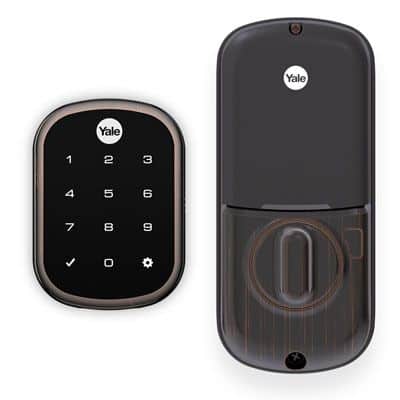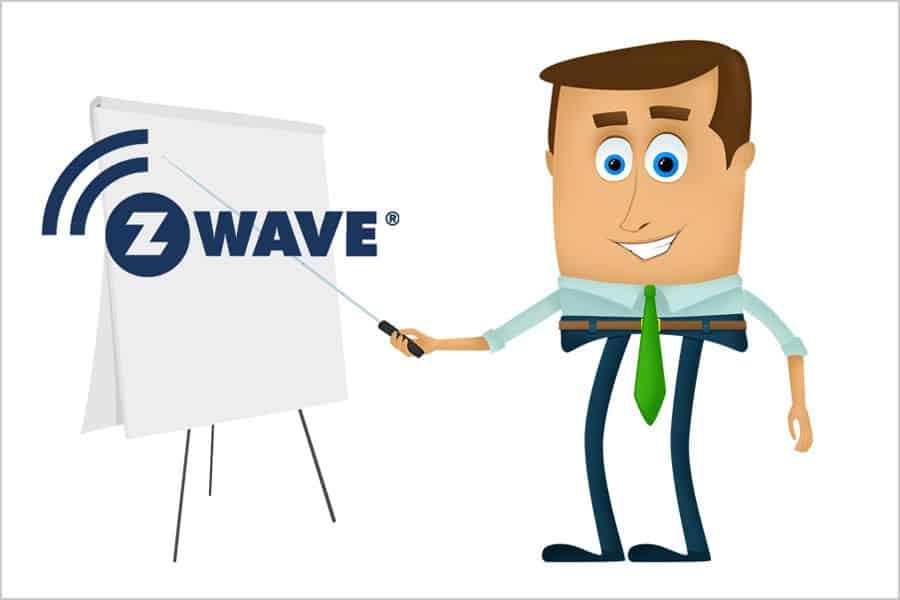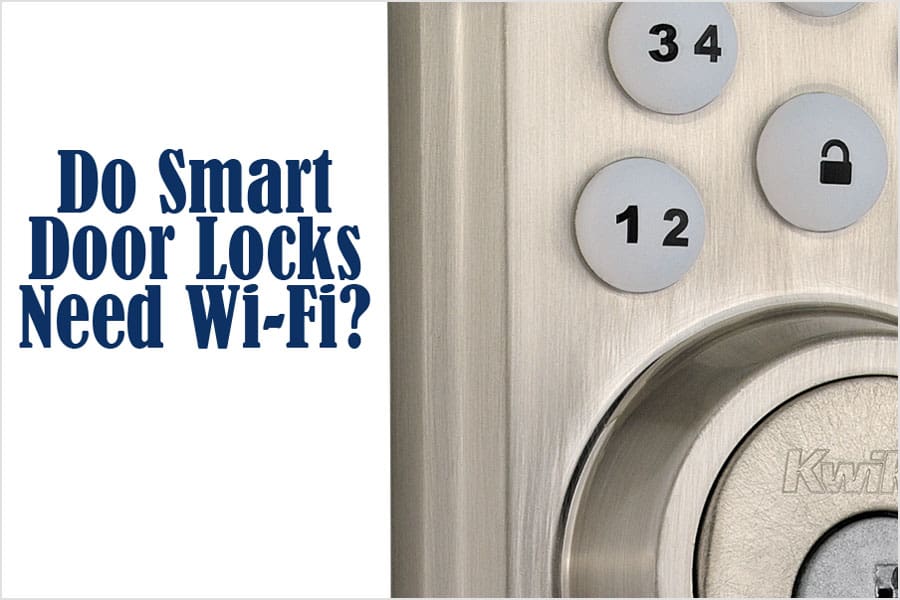Z-Wave Explained: What It Is and How It Works
AUTHOR: Carlos ParasUPDATED: November 20, 2024
The smart home industry is rapidly growing and now that the Internet of Things (IoT) is becoming more mainstream, consumers are looking for the best products to install in their home automation systems.
A subset of devices has become very popular with smart home enthusiasts. These devices utilize Z-Wave technology.
In this article I’ll explain what Z-Wave is, how it works, and why Z-Wave devices are so widely used.
What is Z-Wave? Z-Wave is a wireless communication protocol that was developed in 1999 by a Danish company named Zensys. It operates in a mesh network topology in the 800-900MHz radio frequency range. Z-Wave is globally supported by over 700 device manufacturers and service providers.
Smart Home Deals @ AmazonZ-Wave History
Zensys released their first Z-Wave chipset, the 100 series, in 2003. They released their 200 series chipset in 2005, attracting attention with its high performance, low cost ZW0201 chip.
Also in 2005, the Z-Wave Alliance was established by five industry leading companies. Their main purpose was to advocate for the use and expansion of Z-Wave technology.
Things were looking great for Zensys in 2006 when Intel Capital, Intel’s mergers and acquisitions division, decided to invest in Zensys. Intel joined the Z-Wave Alliance shortly thereafter.
In 2008, Sigma Designs bought Z-Wave and merged it into their headquarters.
Z-Wave Plus was introduced in 2013 as the 500 series chipset. It brought increased battery life, longer range, and four times the memory compared to older series.
Sigma Designs sold Z-Wave in 2018 to its current owner, Silicon Labs, for $240 million.
In 2019, Silicon Labs introduced the Z-Wave Plus 700 series which promises even better battery life than the 500 series, 150% longer range than the 500 series, along with easier and faster product development. All of this, while offering 100% interoperability and backward compatibility with all Z-Wave products.
Z-Wave Alliance
The Z-Wave Alliance is a group of companies and organizations that have come together to promote the use and awareness of Z-Wave technology.
According to their website, the Z-Wave Alliance’s mission and goals are to:
- "Promote consumer awareness and recognition of Z-Wave technology as the trusted standard for wireless control."
- "Ensure interoperability between systems and devices from all members."
- "Provide opportunities and processes for collaboration on future products and services."
- "Accelerate the adoption of Z-Wave control products."
- "Offer trainings for developers, engineers and integrators that extend the knowledge base and broaden Z-Wave penetration worldwide."
What this basically means is that they want consumers to be informed about Z-Wave technology and why they should use it.
They want to make sure that each product, from every member in the alliance, works seamlessly with each other. This way consumers don’t have to worry about integration and configuration issues when using devices from different companies.
They also want to make Z-Wave devices mainstream amongst consumers, especially those in the smart home niche. And finally, they want to increase the support of Z-Wave technology amongst the developers and engineers create the devices that consumers use.
Some of the organizations that make up the Z-Wave Alliance are: Association of Home Appliance Manufacturers (AHAM), Consumer Electronic Association (CEA), Continental Automated Buildings Association (CABA), Continua Health Alliance (CHA), Custom Electronic Design and Installation Association (CEDIA), International Telecommunication Union (ITU), Internet Protocol for Smart Objects (IPSO) Alliance, National Institute of Standards and Technology (NIST), Open Automated Demand Response (OpenADR) Alliance, and Universal Smart Network Access Port (USNAP) Alliance.
As you can tell by their names, most of the companies and organizations are involved with the Internet of Things and smart home technology.
How Does Z-Wave Work?
We are going to get a bit technical here, so put on your thinking cap and read on to find out how Z-Wave technology works!
Z-Wave Mesh Network
Z-Wave technology revolves around a concept called a Mesh Network topology. What is a mesh network, you ask? Well, just like the name implies, devices in the network are “mesh”-ed together.
In other words, the devices in the network are interconnected with each other creating multiple routes of communication.
Every device that has a Z-Wave SoC (System on Chip) can communicate with other devices in the network, provided they are within range of each other, of course. In a smart home system, each Z-Wave certified device acts as a node in the mesh network; be it a smart lightbulb, a smart door lock, or a smart thermostat.
If a device is outside the range of the central controller, it can still be reached because each device that is connected in a Z-Wave network can pass on a signal or instruction to the target device.
There is a limit, however. A message can be sent through a maximum of four nodes. Still, this shouldn’t pose too much of a problem since Z-Wave devices have a 100-meter signal range and Z-Wave Plus extends that to a 167-meter radius.
Z-Wave Radio Frequencies
Every electrical appliance in your home utilizes some sort of radio frequency radiation. Be it your microwave, Wi-fi router, cell phone, or TV. And different types of radiation operate on different frequencies and wavelengths.
As mentioned earlier, Z-Wave operates in the 800-900MHz frequency range. This means Z-Wave products will not encounter interference from devices that use other frequency bands like Wi-Fi and Bluetooth, both of which operate on the 2.4GHz band.
How Z-Wave Transfers Signals and Data

Yale Assure Lock SL - Image Courtesy of: Yale
Z-Wave technology is comprised of three layers: the Radio Layer, the Network Layer, and the Application Layer.
The Radio Layer is responsible for deciding how a signal is transferred between the network and the actual radio hardware. The Network Layer takes care of data transfer between connected devices. While the Application Layer decides which message goes to which device to be executed.
A critical part of Z-Wave technology is its Network Layer architecture. The Network Layer consists of three sub-layers: The MAC (Media Access Control) layer, the Transport Layer, and the Routing Layer.
The MAC and Transport Layer operate much like any other wireless transfer system. The Routing Layer makes sure messages that are being transmitted make it to the destination node.
Every command that is sent from a sender node to a receiver node is acknowledged by the receiver node. If an acknowledgement is not received by the sender node, it will try sending the message up to three times.
If the signal is still not received, the sender node gives up and informs the user that an error has occurred.
This is very useful as the user will now know exactly which device in their smart home system is faulty, instead of guessing and wondering what went wrong and where.
Z-Wave Network Identification Protocol
Each device in a Z-Wave network has two identifying properties.
The first is the Home ID which is shared across all nodes in a network. It indicates that all the devices belong to the same Z-Wave network. Devices in the same network will only be able to communicate with devices within that network.
The second identifier is the Node ID. As you can guess, this is the individual ID of each device in the network and it is unique to each node.
Think of it as similar to the naming convention within a family. Each person has their own unique first name (like a Node ID) followed by one common surname (like a Home ID).
Z-Wave Device Types and Identification Procedure
There are two basic device types of Z-Wave products. The first type is a Controller. The second type is a Slave.
A Controller is a device that can control other Z-Wave devices. A Slave, on the other hand, is a device that can be controlled by other Z-Wave devices.
A Controller has a factory set Home ID which cannot be changed. A Slave does not have a set Home ID. A Slave’s Home ID is set by the Primary Controller of its network.
If a Slave device accepts the Home ID from the Primary Controller, it then becomes a node in the network. The primary controller will then give an individual Node ID to each device added into the network.
Benefits of Z-Wave
The Z-Wave protocol offers many benefits to users. Let’s take a look at some of them here.
Low Frequency = Low Energy Consumption = Longer Battery Life
One of the biggest benefits of Z-Wave is that it operates on a lower frequency band, thereby consuming less power.
Previously, Z-Wave devices could run for up to a year on one battery. But now, with Z-Wave Plus, one device can be powered for as long as 10 years on a single coin battery.
In addition to low power consumption, Z-Wave devices emit very little electromagnetic radiation. So, for those with health concerns about being around so many devices emitting electrosmog, you have little to worry about.
In fact, if you look at the numbers and do the calculation, the radiation emitted from a Z-Wave device is 4,000 times less than a mobile phone.
Easy Installation
Another benefit of Z-Wave devices is just how cheap and easy it is to set up compared to other smart home device protocols. All you have to do is add the device to your network and you can start controlling it from your smartphone or computer.
There’s no need for a professional contractor or technician since there’s no elaborate installation process. This is great news for DIY smart home enthusiasts.
Interoperability
Interoperability is another major benefit. Interoperability means that every Z-Wave device, no matter which company manufactured it, can interact with other Z-Wave devices without any extra software or equipment.
Z-Wave devices seamlessly connect with each other. This feature makes Z-Wave one of the most popular protocols in smart home automation. There are over 1,700 Z-Wave products available from over 300 manufacturers worldwide.
Z-Wave Range
Z-Wave devices have an outdoor range of 100 meters (167 meters for Z-wave Plus). Indoors, Z-Wave devices have about a 70 to 90-meter signal radius due to walls and building materials.
Here’s the kicker though, each device connected in a network acts like a repeater to extend the range further.
For example, you could have a device that is 500 meters away from the main controller. If you have four devices connected between those two, the signal from the controller will get passed along the four devices to reach the targeted receiving device.
As mentioned earlier, four nodes is the maximum allowed to hand off a signal through a network.
Z-Wave Security
Z-Wave is considered to be one of the most secure home automation protocols today.
When Z-Wave devices send data to one another, the transmitters send the MAC address of each device and encrypt it with the data to be sent. Additionally, when you’re pairing devices, a network key is shared between the devices to allow them to communicate with each other.
The type of encryption used for the data is the AES 128 symmetric encryption algorithm. It is a very secure and very difficult to crack encryption method.
However, at Shmoocon 2016, Ben Ramsey and Joseph Hall, showed that they could hack and control Z-Wave devices. Shmoocon is a yearly security and hacker convention held in the United States.
Ramsey and Hall tested 33 Z-Wave devices and demonstrated that only 9 of them had any actual encryption going on.
Out of eight door locks tested, only three were using encryption.
As alarming as this sounds, the Z-Wave Alliance immediately went to work and in 2017 they announced a mandatory security implementation for every single device that uses the Z-Wave protocol.
They called it the Security 2 (S2) framework. It is one of the most advanced security options for smart home devices today. The new framework improves security via new physical methods.
All Z-Wave devices will have stickers or printed labels with a QR or pin code on them. The code will be used when devices are being authenticated and during the pairing procedure. Which means, unless a hacker has physical access to the actual device, they won’t be able to hack it.
In addition, online hack protection is administered through the implementation of TLS 1.1 tunneling. Man in the middle and brute force attacks are now impossible thanks to secure key exchange utilizing ECDH (Elliptic Curve Diffie-Hellman).
That’s a lot of technical jargon, but it basically means that there are new state of the art techniques and algorithms implemented into Z-Wave devices to provide the latest security measures for your smart home automation system.
Recommended Products
- Works with Alexa for voice control (hub required, Alexa device and hub sold separately). Alexa can also provide notifications...
- Simply speak to lock your door. Tell Alexa, Siri or the Google Assistant to control your August Smart Lock Pro (requires...
- Control access for anyone: Grant access for a few weeks, a few hours, or a few minutes. It’s up to you. August Smart Locks...
- Be sure you're secure with DoorSense. Only August has DoorSense to tell you if your door is securely closed and locked.
- Always know who is coming and going. Track activity at your doorstep with a 24/7 activity feed.
- Pair with a Z Wave smart home or security system like Samsung SmartThings or Ring Alarm to lock and unlock from...
- Hands free voice control requires Z Wave smart home system and compatible voice assistant; Alexa device (sold separately)
- Easy to install with just a screwdriver; Unique Snap ‘n Stay technology snaps the deadbolt onto the door so both hands are...
- Use the finger print resistant touchscreen to share up to 30 access codes instead of keeping track of spare keys.Keying:...
- The keypad is backlight. The keypad illuminates blue so it can be used at night!!
- Unlock your door without keys by entering your code on the lock's backlit keypad; Lock the door behind you by pressing any...
- Lock and unlock your door from anywhere by adding the lock to a compatible Z-Wave smart home or alarm system and app (i.e....
- Replaces your existing deadbolt in minutes on standard doors, 1-3/4" to 2-1/4" thick with just a screwdriver. No additional...
- Comes with two physical keys for added peace of mind
- Works with Alexa via a compatible hub ,Features may vary based on Z-Wave controller. Requires compatible system for smart...
- Item Package Dimension: 11.05L x 6.019W x 5.74H inches
- Item Package Weight - 4.075 Pounds
- Item Package Quantity - 1
- Product Type - LOCK
No products found.
No products found.
No products found.
No products found.
- Revolutionary design – QuickFit and SimpleWire technologies offer groundbreaking home automation features. Unique...
- QuickFit – Improved components reduced the housing depth by up to 20% compared to previous Z-Wave models and eliminated the...
- SimpleWire – Patented auto-detecting line/load terminals support fast installation by identifying line and load wires and...
- Voice control – Enjoy the convenience of voice control with Google Assistant or Amazon Alexa when connected through a...
- Switch upgrade – Easily replace any standard in-wall switch equipped with a neutral wire to remotely turn ON/OFF and create...
- FULL RANGE DIMMING – Give your space the perfect amount of light with the ability to customize the brightness levels from 0...
- WIRELESSLY CONTROL & SCHEDULE LIGHTS AND OTHER DEVICES – Schedule timed events for connected devices. Customize scenes for...
- ALEXA COMPATIBLE (HUB REQUIRED) - Requires an Alexa supported hub for voice control with Amazon Echo Products (Alexa device...
- REQUIRES A Z-WAVE CERTIFIED HUB - Compatible with the following Z-Wave Hubs: Honeywell, Ring, SmartThings, Wink, HomeSeer,...
- IN-WALL INSTALLATION WITH HARD WIRED CONNECTIONS (NEUTRAL WIRE REQUIRED) – Replace your existing in-wall switch in as...






